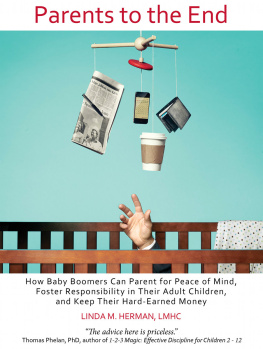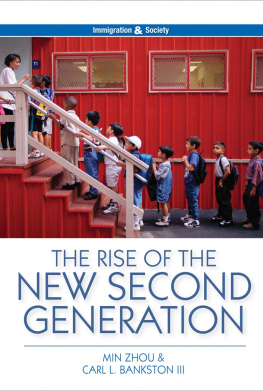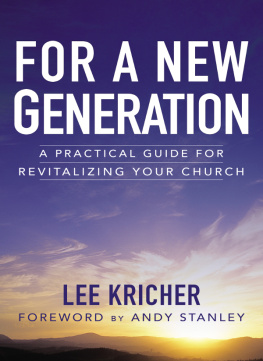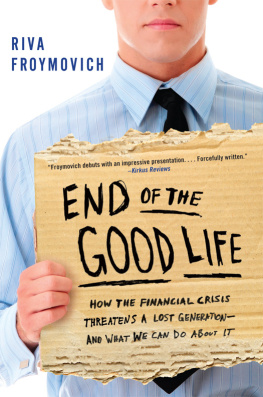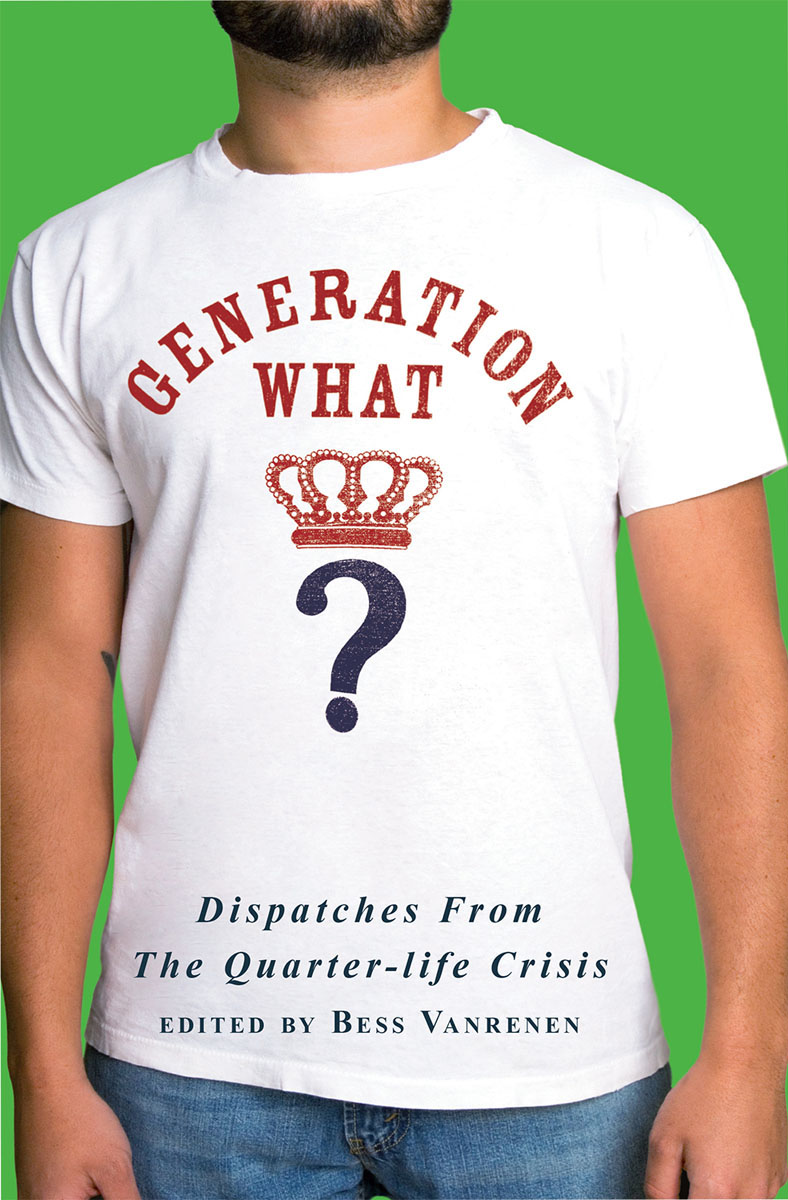

Published by: speck press, speckpress.com
An imprint of Fulcrum Publishing
Copyright 2007 Darker Country Hal Niedzviecki; Final Chapter Mark Dye; 11.2.04 Courtney E. Martin; Welcome to Afghanistan Matt Farwell; Weirdoes, Writers, and the Quarter-Life Crisis Erika T. Wurth; Hailing a Cab Catherine Strawn; How I Became a Bed-Maker Kate Torgovnick; How to Get a Job and Survive the QLC with Dignity, Honor, and the American Way Harmon Leon; Afterlife Nick Burd; The 21st Mile Caitlin Dougherty; I Was a World-Class Druggie Vince Darcangelo; Non-Babe in Pornland Joshua M. Bernstein; Listen to the Sounds of the House Jared Jacang Maher; My Fathers Mid-Life Crisis Bess Vanrenen; Salvation in Wordplay Justin Maki; Marys Bed Rebecca Landwehr; The Ring Jennifer Banash
Printed and bound in Canada
Printed using 100% post-consumer waste recycled paper speck press is a member of the Green Press Initiative
ISBN: 1-933108-12-6, ISBN13: 978-1-933108-12-4
Book layout and design by: Margaret McCullough
All rights reserved. No part of this book may be reproduced or transmitted in any form or by any means, electronic or mechanical, including photocopying, recording, or by an information storage and retrieval systemexcept by a reviewer who may quote brief passages in a reviewwithout permission in writing from the publisher.
Library of Congress Cataloging-in-Publication Data
Generation what? : dispatches from the quarter-life crisis / [edited by] Bess Vanrenen.
p. cm.
ISBN-13: 978-1-933108-12-4 (pbk. : alk. paper)
ISBN-10: 1-933108-12-6 (pbk. : alk. paper)
1. Young adults--Attitudes. 2. Young adults--Psychology. 3. Young adults--Biography. 4. Generation Y--Attitudes. 5. Generation Y--Psychology. 6. Adulthood--Psychological aspects. I. Vanrenen, Bess.
HQ799.5.G457 2007
10 9 8 7 6 5 4 3 2 1
To Jared, for lots and lots of reasons; to my parents, for being smart, interesting, and wonderful people.
ACKNOWLEDGMENTS Thanks to the contributors for sharing their stories, some, amazingly, before I had anything to offer them in return. Thanks to Derek Lawrence for his interest in this project, to Amy Haimerl, Jared Jacang Maher, and my family for their help editing, to Susan Hill Newton for her enormous help strengthening the writing throughout, and to Margaret McCullough for the fabulous cover and interior design.
TABLE OF CONTENTS
INTRO DUCTION
A new generation is storming college campuses and big cities, vying for entry-level positions, buying sensible but chic cars, and sporting outfits that will later give reason to blush. They go by any number of names: Gen Y, The Simpsons Generation, the Pepsi Generation, the MTV GenerationQuick, define them! Read Salon or Slate, watch MTV or just the local news, they all have a word on the subjecteven the commercials.
Gen Yers are multitaskers. Their time is important to them. They work so they can play, explains a stern, but affable, blonde anchorwoman, while doing a piece on youths in the workplace. This generation is lazy. They have no accountability, an aging baby boomer complains about the companys younger employees. Theyre young, bright, brazen! counters another. They need to quit whining and get a job, chimes in one more voice.
Cultural critics cant even agree on the age group under discussion. Heres one list of designations used by some advertisers: Matures, born 19091945; Baby Boomers, born 19461964; Generation X, born 19651984; Generation Y or Milleniums, born 1985present. However, Rob Owens, author of Gen X TV, includes just those born between 1965 and 1975.
On one subject, though, many agree. It appears as though twentysomethings and, yes, even thirtysomethings today have a hard time figuring out what to do with their (our) lives, and this apparent indecision triggers strong reactions. Some young people undoubtedly relate, while others think its a hot crock of crap. This set of parents welcomes their child back to the hearth, but that pair kicks the kid to the curb. Many in this age group seem to be suffering from whats now called a quarter-life crisis, and here we have the subject of Generation What?
Alexandra Robbins and Abby Wilner, who co-wrote Quarterlife Crisis in 2001, noticed how so many twentysomethings felt lost on the road from young adulthood to adulthood. In their book, they identified six major signs of such a crisis: You do not know what you want; your twenties are not what you expected; you have a fear of failure; you cannot let go of childhood; you waffle over decisions; and you constantly compare.
They brought the term into the pop-culture realm, and it caught on like an STD. Musicians such as John Mayer as well as sociologists have accepted it into their lexicon. The references to the feelings associated with a quarter-life crisis are rampant in movies, TV shows, songs, and blogs. The romantic comedy Quarter Life Crisis came out in 2006 as well as a novel called Twentysomething: The Quarter-Life Crisis of Jack Lancaster, and theres an L.A. band going by the same moniker. Even Ph.D.s are studying how the period between adolescence and adulthood has widened to unforeseen proportions. Some of these books include On the Frontier of Adulthood, Emerging Adulthood: The Winding Roadfrom the Late Teens Through the Twenties, and The Changing Adolescent Experience: Societal Trends and the Transition to Adulthood.
So whats the difference between a quarter-life crisis and a mid-life crisis, or any other life crisis for that matter? Havent twenty year olds been having breakdowns sinceforever?
The twenties are a particularly volatile age. Look, for instance, at the poets of the nineteenth and twentieth centuries. Suicide, institutionalization, suicide again, breakdowns, manic episodes (that typically involved posturing around London in a cape) all come to mind. The Lost Generation, the Greatest Generation, and the Beat Generation were all filled with tortured souls.
But different social circumstanceswhether its a world war, an economic depression, or even a boombring on changes to the existing social norms and the way humans relate to each other. As a result, the crisis a young person experiences today may be distinct from ones felt in years past.
Back in the fifties and early sixties, most young Americans were getting married and having babies by their early twenties. Folks found a job after high school or college and stuck with it to the bitter end. Sex before marriage was the exception, not the rule (at least thats what they say). But the civil rights movement, the sexual revolution, feminism, and anti-war protests of that era changed the future for kids.
Picture a hip lady of Dylans times-they-are-a-changing era. Long hair flowing, she attends a few protests at her college campus. At some point, she meets a like-minded fellow and they run off to the courthouse to get married. Though she has a lot more freedom than her mother, there are still a lot of careers she cant really pursue, a lot of lifestyles not quite available to her. Soon she has a baby in tow, and since she is getting paid much less than her hubby anyway, she decides to quit working and take care of the child. She will undoubtedly raise this child much differently than her parents raised her. Now, picture her grown-up daughter.
Older generations paved the way for a whole new style of living. Rather than feeling compelled to settle down at twenty-one, the new generation can go to college or opt out, date several people, try out a few different jobs, and wait until theyre ready for marriage. They dont have to get married either, or if theyre gay they cant, but thats a whole different story.
Next page


